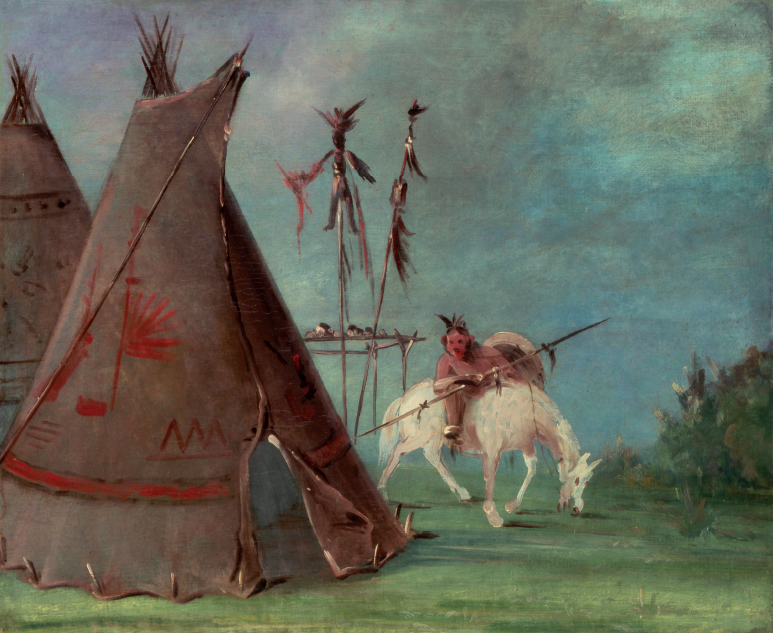Exploring American Histories: Printed Page 309
Exploring American Histories, Value Edition: Printed Page 261
The Battle for Texas

While whites in Georgia sought Cherokee land, those on the frontier looked toward Texas. Some Southerners had moved into Texas in the early nineteenth century, but the Adams-Onís Treaty of 1819 guaranteed Spanish control of the territory. Then in 1821 Mexicans overthrew Spanish rule and claimed Texas as part of the new Republic of Mexico. But Mexicans, like the Spaniards before them, faced serious competition from Comanche Indians, who controlled vast areas to the north and west and launched raids into Texas for horses and other livestock.
Eager to increase settlement in the area and to create a buffer against the Comanches, the Mexican government granted U.S. migrants some of the best land in eastern Texas. It hoped these settlers—many of whom brought slaves to cultivate cotton—would eventually spread into the interior, where Comanche raids had devastated Mexican communities. To entice more Southerners, the Mexican government negotiated a special exemption for U.S. planters when it outlawed slavery in 1829. But rather than spreading into the interior, U.S. farmers and planters stayed east of the Colorado River, out of reach of Comanche raiders and close to U.S. markets in Louisiana.
While the Mexican residents of Texas developed a vibrant Tejano culture that combined Catholicism, Spanish language and culture, and indigenous customs, U.S. settlers resisted acculturation. Instead, they continued to worship as Protestants, speak English, send their children to separate schools, and trade mainly with the United States. By 1835 the 27,000 white Southerners and their 3,000 slaves far outnumbered the 3,000 Mexicans living in eastern Texas.
Forming a majority of the east Texas population and eager to expand their plantations and trade networks, growing numbers of U.S. settlers demanded independence. See Document Project 10: Claiming Texas, page 319. Then in 1836 Mexicans elected a strong nationalist leader, General Antonio López de Santa Anna, as president. He sought to rein in Tejanos angered over their vulnerability to Comanche attacks and to curb American settlers seeking further concessions. When Santa Anna appointed a military commander to rule Texas, independence-minded U.S. migrants organized a rebellion. On March 2, they declared eastern Texas an independent republic and adopted a constitution that legalized slavery. Some elite Tejanos, long neglected by authorities in Mexico City, sided with the rebels. The rebellion appeared to be short-lived, however. On March 6, 1836, General Santa Anna crushed settlers defending the Alamo in San Antonio. His troops killed all 250 men at the fort but freed the women and children. Soon thereafter, Santa Anna captured the U.S. settlement at Goliad.
Although Santa Anna’s troops suffered more than 1,500 casualties, several times those of the rebel forces, the general was convinced that the uprising was over. But the U.S. government, despite its claims of neutrality, aided the rebels with funds and army officers. Newspapers in New Orleans and New York picked up the story of the Alamo and published dramatic accounts of the battle, describing the Mexican fighters as brutal butchers bent on saving Texas for the pope. These stories, though more fable than fact, increased popular support for the war at a time when many Americans were growing increasingly hostile to Catholic immigrants in the United States.
As hundreds of armed volunteers headed to Texas, General Sam Houston led rebel forces in a critical victory at San Jacinto in April 1836. While the Mexican government refused to recognize rebel claims, it did not try to regain the lost ground in east Texas. Few of the U.S. volunteers arrived in time to participate in the fighting, but some settled in the newly liberated region. Still, the failure of Santa Anna to recognize Texan independence kept the U.S. government from granting the territory statehood for fear it would lead to war with Mexico. Fortunately for the rebels, the Comanche nation did recognize the Republic of Texas and developed trade relations with residents to gain access to the vast U.S. market.
Meanwhile President Jackson worried that admitting a new slave state might split the national Democratic Party just before the fall elections. To limit debate on the issue, Congress passed a gag rule in March 1836 that tabled all antislavery petitions without being read. Nevertheless, thousands of women and men from Ohio to Massachusetts still flooded the House of Representatives with petitions opposing the annexation of Texas.